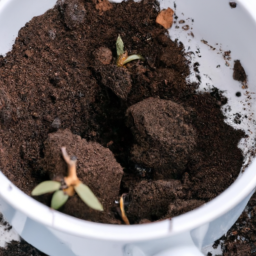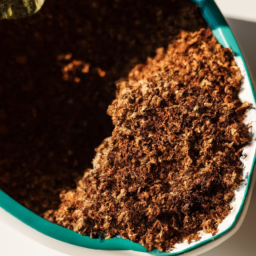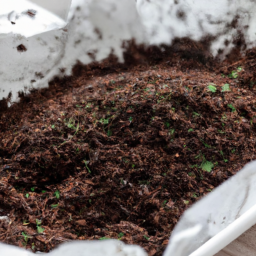
Have you ever wondered what indoor plants like coffee grounds? Well, you’re in luck! In this blog post, we will dive into the world of indoor gardening and explore the benefits of using coffee grounds as a natural fertilizer for your beloved houseplants. Coffee grounds are not only a waste product that can be repurposed, but they also provide several nutrients that plants love. So, if you’re a coffee lover and a plant enthusiast, keep reading to find out how you can give your indoor plants a caffeine boost with coffee grounds!
Benefits of Using Coffee Grounds for Indoor Plants
Are you a coffee lover who also happens to be a plant enthusiast? Well, you’re in for a treat! Did you know that coffee grounds can be a fantastic addition to your indoor plants’ care routine? Yes, you heard it right! Those leftover coffee grounds can do wonders for your leafy companions. In this article, we will explore the various benefits of using coffee grounds for indoor plants and provide you with a step-by-step guide on how to do it effectively. So, grab a cup of joe and let’s dive in!
Enhanced Soil Fertility and Nutrient Content
One of the primary benefits of using coffee grounds for indoor plants is their ability to enhance soil fertility. Coffee grounds are rich in essential nutrients like nitrogen, potassium, phosphorus, and magnesium. When added to the soil, these nutrients gradually break down and release, providing a steady supply of nourishment to your plants.
Additionally, coffee grounds contain organic matter that improves soil structure and promotes microbial activity. This, in turn, helps in nutrient absorption and root development. So, if you want your indoor plants to thrive and flourish, incorporating coffee grounds into their soil can be a game-changer.
However, it is crucial to note that coffee grounds are acidic in nature. While this acidity is beneficial for certain plants, it may not be suitable for all. Acid-loving plants like azaleas, roses, hydrangeas, and blueberries will benefit the most from coffee grounds. On the other hand, plants that prefer alkaline soil, such as succulents or cacti, may not appreciate the addition of coffee grounds.
To utilize coffee grounds effectively, mix them with your potting soil in a ratio of 1:3 (one part coffee grounds to three parts soil). This will ensure that the acidity is balanced and your plants receive the necessary nutrients without any adverse effects.
Natural Pest Deterrent
Are pesky insects wreaking havoc on your indoor plants? Coffee grounds can come to the rescue! Coffee contains compounds like caffeine and diterpenes, which act as natural deterrents for pests like slugs, snails, ants, and even mosquitoes. By sprinkling coffee grounds around the base of your plants or incorporating them into the soil, you can create a barrier that keeps these unwanted visitors at bay.
Moreover, coffee grounds also repel cats due to their strong smell. If you have feline friends who love to nibble on your plants, adding coffee grounds to the soil or placing them strategically around the pots can help protect your greenery from their curious paws.
However, it is important to remember that while coffee grounds can be effective in deterring pests, they are not a foolproof solution. If you notice a severe infestation, it is advisable to consult with a professional or explore other pest control methods.
Improved Water Retention and Drainage
Indoor plants require a delicate balance of water to thrive. Coffee grounds can play a significant role in maintaining this balance by improving water retention and drainage in your plant’s soil.
The organic matter present in coffee grounds acts as a sponge, absorbing excess moisture and preventing waterlogged soil, which can lead to root rot. On the other hand, coffee grounds also help in retaining moisture during dry spells, ensuring that your plants stay hydrated for longer periods.
To utilize coffee grounds for improved water retention and drainage, mix them with your potting soil in a ratio of 1:2 (one part coffee grounds to two parts soil). This will create a well-draining yet moisture-retaining environment, ideal for most indoor plants.
However, it is essential to monitor your plants’ moisture levels regularly and adjust the watering accordingly. Every plant has unique requirements, and while coffee grounds can assist in maintaining moisture balance, overwatering can still be detrimental.
Now that you are aware of the benefits of using coffee grounds for indoor plants, it’s time to put this knowledge into action. Remember to choose the right plants that thrive in acidic soil, utilize coffee grounds in the appropriate ratios, and monitor your plants’ moisture levels. By incorporating coffee grounds into your plant care routine, you can enjoy healthier, more vibrant indoor plants that will make your space come alive!

Best Indoor Plants that Thrive with Coffee Grounds
Indoor plants not only add beauty to our living spaces but also provide numerous health benefits. They purify the air, improve humidity levels, and reduce stress. If you’re a coffee lover, you’ll be delighted to know that your used coffee grounds can be a fantastic addition to your indoor plant care routine. Coffee grounds are rich in nutrients like nitrogen, phosphorus, and potassium, which are essential for plant growth. In this article, we will explore the best indoor plants that thrive with coffee grounds and provide you with a step-by-step guide on how to use them effectively.
1. Peace Lily
The Peace Lily is a popular choice among indoor plant enthusiasts due to its elegant white flowers and ability to purify the air. This plant thrives in low light conditions, making it perfect for offices or rooms with limited sunlight. Coffee grounds can be used as a natural fertilizer for Peace Lilies, providing them with the necessary nutrients for healthy growth.
To use coffee grounds for your Peace Lily, start by collecting your used coffee grounds and allowing them to cool and dry. Once dried, sprinkle a thin layer of coffee grounds on the soil surface around the base of the plant. Gently work the coffee grounds into the soil using a fork or your fingers, being careful not to damage the plant’s roots. Water the plant as usual, and the coffee grounds will slowly release their nutrients over time.
It’s important to note that while coffee grounds are beneficial for Peace Lilies, they should be used in moderation. Excessive use of coffee grounds can lead to a buildup of acidity in the soil, which may harm the plant. Therefore, it’s recommended to apply coffee grounds to your Peace Lily once every few months.
2. Spider Plant
The Spider Plant is another fantastic indoor plant that can thrive with the help of coffee grounds. Known for its long, arching leaves and ability to remove toxins from the air, the Spider Plant is a low-maintenance choice for any indoor space. Coffee grounds can provide an extra boost of nutrients to support its growth.
To use coffee grounds for your Spider Plant, follow a similar process as with the Peace Lily. Collect and dry your used coffee grounds, then sprinkle a thin layer around the base of the plant. Gently work the coffee grounds into the soil and water as usual. The Spider Plant will benefit from the slow release of nutrients from the coffee grounds, promoting healthy foliage and overall growth.
Remember to use coffee grounds sparingly to avoid over-fertilization. Applying coffee grounds once every few months should be sufficient to keep your Spider Plant happy and thriving.
3. Pothos
Pothos, also known as Devil’s Ivy, is a popular trailing plant that is perfect for hanging baskets or as a climbing plant. Its heart-shaped leaves and ability to tolerate a variety of light conditions make it an excellent choice for indoor gardening beginners. Coffee grounds can enhance the growth of Pothos plants and keep their foliage vibrant.
To use coffee grounds for your Pothos, follow the same steps as with the previous plants. Allow the coffee grounds to cool and dry, then sprinkle them around the base of the plant. Gently work the coffee grounds into the soil, taking care not to disturb the plant’s roots. Water the plant as usual, and the coffee grounds will gradually release their nutrients, promoting healthy and lush growth.
As with all plants, it’s crucial to avoid excessive use of coffee grounds. Applying coffee grounds to your Pothos once every few months will provide the necessary nutrients without causing any harm.
Remember, while coffee grounds can be beneficial for indoor plants, they should not be the sole source of nutrients. It’s important to use them in conjunction with a balanced fertilizer and regular watering to ensure optimal plant health. With the right care and a sprinkle of coffee grounds, your indoor plants will thrive and bring joy to your living space.

How to Use Coffee Grounds as Fertilizer for Indoor Plants
Introduction
Indoor plants not only add beauty to our living spaces but also provide numerous health benefits. To keep them thriving, it’s essential to provide proper care and nutrition. One surprising and cost-effective way to fertilize your indoor plants is by using coffee grounds. Yes, you heard it right! Coffee grounds, which are rich in organic matter and nutrients, can be an excellent fertilizer for your beloved green companions. In this guide, we will explore the benefits of using coffee grounds as fertilizer and provide you with a step-by-step approach to incorporate this natural wonder into your indoor plant care routine.
The Benefits of Coffee Grounds as Fertilizer
Coffee grounds offer several advantages when used as fertilizer for indoor plants. Firstly, they are a fantastic source of organic matter, which helps improve soil structure, water retention, and nutrient availability. Secondly, coffee grounds contain essential nutrients like nitrogen, potassium, phosphorus, and trace minerals that plants require for healthy growth. Lastly, coffee grounds act as natural pest repellents, deterring common indoor plant pests such as ants, slugs, and snails.
However, it’s crucial to note that coffee grounds should be used in moderation and in combination with other fertilizers or compost. Using them in excess or without proper preparation can lead to pH imbalances and hinder plant growth. Now, let’s dive into the step-by-step guide on how to use coffee grounds as fertilizer for your indoor plants.
Step 1: Collecting and Preparing the Coffee Grounds
The first step is to collect coffee grounds. You can save them from your morning brew or ask local coffee shops if they are willing to share their used grounds. Once you have a sufficient amount, it’s time to prepare them for use. Spread the coffee grounds on a tray or baking sheet and let them dry completely. This prevents mold growth and makes it easier to handle and apply them to your plants.
Remember, it’s essential to use only coffee grounds and not coffee beans or instant coffee, as they won’t provide the same benefits and may harm your plants.
Step 2: Mixing Coffee Grounds with Compost
Before applying coffee grounds directly to your indoor plants, it’s advisable to mix them with compost. This helps balance the pH levels and ensures a more gradual release of nutrients. Take a container and combine equal parts of coffee grounds and compost. Stir the mixture thoroughly to ensure even distribution.
Compost can be homemade or store-bought, but make sure it is well-rotted and free from any chemicals or contaminants. If you don’t have compost readily available, you can substitute it with potting soil or a balanced organic fertilizer.
Step 3: Applying Coffee Grounds to Indoor Plants
Now that your coffee ground and compost mixture is ready, it’s time to apply it to your indoor plants. Follow these steps:
1. Choose the right plants: Not all indoor plants thrive with coffee grounds. Acid-loving plants like African violets, ferns, azaleas, and roses are more likely to benefit from coffee ground fertilization. Avoid using coffee grounds on plants that prefer alkaline soil conditions.
2. Check the soil moisture: Before fertilizing, ensure that the soil is slightly moist. If it’s too dry, water your plants a day before applying the coffee ground mixture.
3. Apply the mixture: Sprinkle the coffee ground and compost mixture evenly around the base of your plants, avoiding direct contact with the stems or leaves. Gently work the mixture into the top layer of soil using a fork or your fingers.
4. Water thoroughly: After applying the coffee ground mixture, water your plants thoroughly to help the nutrients penetrate the soil and reach the roots.
5. Repeat the process: Depending on the plant’s needs, you can repeat this process every few weeks or once a month. Monitor your plants closely and adjust the frequency of coffee ground fertilization accordingly.
Conclusion
Using coffee grounds as fertilizer for indoor plants is an eco-friendly and budget-friendly way to enhance their growth and overall health. By following the step-by-step guide outlined above, you can ensure that your indoor plants receive the right amount of nutrients and enjoy the benefits of coffee grounds’ organic matter. Remember, moderation is key, and it’s always best to observe your plants’ response to determine the ideal frequency of fertilization. So, go ahead and give your indoor plants a caffeine boost with the power of coffee grounds!
Let’s bring it all home
Indoor plants are a fantastic addition to any home, bringing a touch of nature and freshness to our living spaces. But did you know that coffee grounds, those leftover remnants from your morning brew, can actually benefit your leafy friends? Yes, that’s right! Coffee grounds can be a secret weapon for plant enthusiasts, providing a natural boost to their growth and overall health.
Firstly, coffee grounds are a great source of nutrients for indoor plants. They contain essential minerals like nitrogen, potassium, and phosphorus, which are vital for plant growth. When used as a fertilizer, coffee grounds slowly release these nutrients into the soil, providing a steady supply for your plants to thrive on. Additionally, coffee grounds help improve the soil’s structure and drainage, which is crucial for preventing root rot and ensuring healthy root development. So, if you’re looking to give your indoor plants a nutritious treat, consider sprinkling some coffee grounds around their base or mixing them into the potting soil.
Here are some questions from our readers:
Q1: Can indoor plants benefit from coffee grounds?
A1: Absolutely! Coffee grounds can be a fantastic natural fertilizer for indoor plants. They contain several essential nutrients like nitrogen, potassium, and phosphorus that plants need to grow and thrive.
Q2: Which indoor plants specifically enjoy coffee grounds?
A2: Many indoor plants appreciate the benefits of coffee grounds. Some popular choices include acid-loving plants like ferns, African violets, snake plants, and peace lilies. However, it’s always a good idea to research the specific needs of your plants before using coffee grounds as a fertilizer.
Q3: How should I use coffee grounds on my indoor plants?
A3: To use coffee grounds as a fertilizer, you can sprinkle them directly on the soil around your plants. It’s best to let the coffee grounds dry out before applying them. You can also mix the coffee grounds with water to create a liquid fertilizer. However, avoid using coffee grounds excessively, as it may lead to over-fertilization.
Q4: Are there any precautions or considerations when using coffee grounds?
A4: Yes, there are a few things to keep in mind. First, avoid using coffee grounds on plants that prefer alkaline soil since coffee grounds are slightly acidic. Additionally, make sure not to use coffee grounds that have been mixed with dairy or sugar, as they can attract pests. Lastly, moderation is key when using coffee grounds as fertilizer. Too much can cause the soil to become overly acidic.
Q5: Can I use coffee grounds from any type of coffee?
A5: Yes, you can use coffee grounds from any type of coffee. Whether it’s regular, decaf, or even flavored coffee, the grounds will still provide beneficial nutrients to your indoor plants. Just make sure the coffee grounds have cooled down and are no longer hot before applying them to your plants.
Dr. Olivia Green is a botanist with over two decades of experience in indoor plant cultivation. She holds a Ph.D. in Plant Biology and has dedicated her career to researching plant behavior in controlled environments. Dr. Green is passionate about helping plant enthusiasts master the art of indoor gardening through her extensive knowledge and practical insights.


